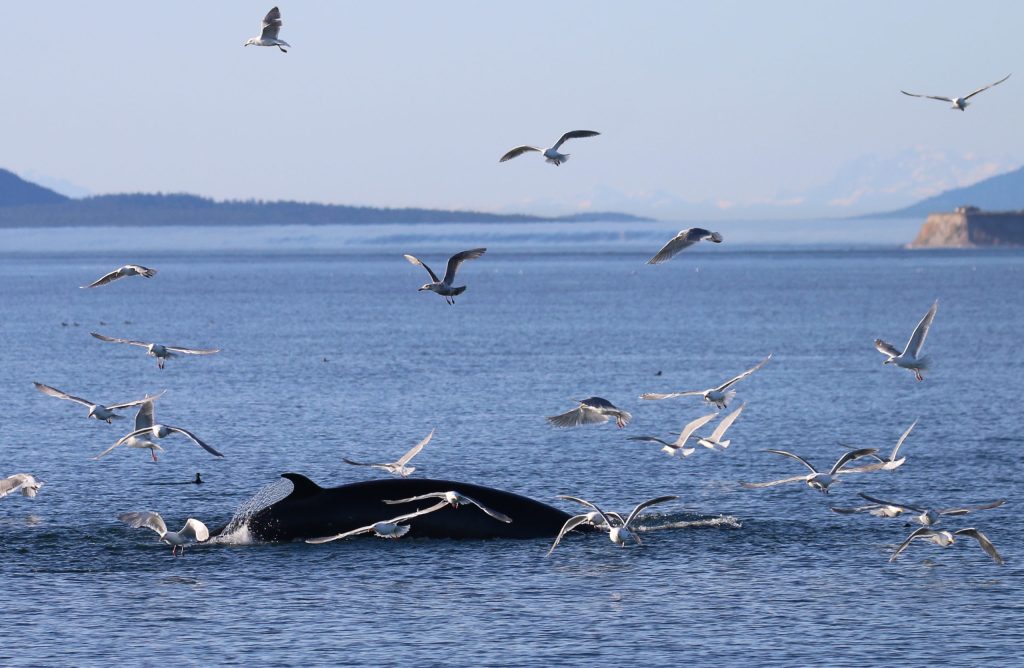2021 Was a Banner Year for Whales in Salish Sea

New Data Show Record Number of Sightings; Baby Boom Continues for Bigg’s Orcas, Humpback Whales
Featured Image: New Bigg’s orca calf T124A7. Photo: Karac Lindsay, Eagle Wing Tours, PWWA
Courtesy of Pacific Whale Watch Association
SEATTLE, WA & VICTORIA, BC – January 11, 2022 – 2021 was a challenging year for many, but for whale lovers on the Salish Sea, it was one of the best years yet, according to year-end data just compiled by the Pacific Whale Watch Association (PWWA) and local researchers.
According to the PWWA, which operates year-round whale watching tours in Washington and British Columbia, Bigg’s killer whales were the most frequently documented whales in the region last year, followed by humpback whales, gray whales, and minke whales. Endangered Southern Resident killer whales were encountered least often. Their declining presence in the Salish Sea has been correlated to a decrease in Fraser River Chinook, according to PWWA naturalists. Many tours viewed more than one whale species during their trips and on Mother’s Day, multiple companies reported “Grand Slams” spotting orcas, humpbacks, minke whales, and gray whales in a single tour. PWWA vessels also administered nearly 900 protective interventions, or ‘sentinel actions,’ in the Salish Sea during 2021, detailed further below.

Breaching humpback whale. Photo: Simon Pidcock, Ocean Ecoventures, PWWA
Monika Wieland Shields, director of Orca Behavior Institute on San Juan Island, confirmed a record-breaking presence of Bigg’s killer whales in 2021. Based on reports from professional whale watchers, regional sightings groups, and shore-based observers, Bigg’s killer whales were documented in the Salish Sea during 1,067 unique sightings across 329 days. The previous record, set in 2019, was 747 unique sightings. In contrast, salmon-eating Southern Resident killer whales were documented on just 103 days, or 28% of the year.
“It has been incredible to witness the continued rise of Bigg’s killer whales in the Salish Sea,” said Shields. “In 2021, there were days when we documented 10 different groups of Bigg’s throughout the region totaling more than 50 whales.”

Feeding minke whale. Photo: Tyson Reed, Island Adventures Whale Watching, PWWA
The Bigg’s killer whale population, which feeds on marine mammals like seals and sea lions, is growing at more than 4% per year according to the Department of Fisheries and Oceans Canada. 11 new Bigg’s calves were born in 2021 including the most recent, T124A7, who was spotted by PWWA member companies near Victoria on New Year’s Eve. The number 7 at the end of the calf’s ID number indicates it is the seventh baby born to 37-year old mother T124A, “Kittiwake”.
“It’s crazy to think that whales like Kittiwake have given birth to so many babies given that the gestation period for orcas is 16-18 months – almost twice that of a human”, says Erin Gless, executive director of the PWWA. “The calf looked great and at one point adorably seemed to take a turn leading the family.”
Bigg’s killer whales are not the only ones experiencing a baby boom. A record 21 humpback whale calves accompanied their mothers to the Salish Sea last year, nearly doubling 2020’s count of 11. The PWWA documented humpback whales on 301 days of 2021. By now, most local humpbacks have made the journey south to breeding grounds in Hawaii, Mexico, and Central America, but a few still remain in the area.

Tail of gray whale #723 Lucyfer. Photo: Justine Buckmaster, Puget Sound Express, PWWA
In September, Seattle-based research organization SR3 reported three pregnancies within the endangered Southern Resident killer whale population. No new calves have been observed yet, but the youngest Southern Resident calf, L125 “Element”, estimated at one year old, was seen in late December by Center for Whale Research and appeared to be doing well.
“Big picture, 2021 was an exciting and encouraging year for whales in the Salish Sea. We look forward to what 2022 may bring,” Gless added.
PROTECTING AREA WHALES
With more whales in the area than in recent history, PWWA operators undertook and documented 880 “sentinel actions” during their 2021 ecotours. Examples of sentinel actions include:
-
Stopping speeding vessels
-
Alerting ferries and cargo ships of whales in the vicinity
-
Removing harmful marine debris like balloons and derelict fishing gear
-
Educating boaters on proper viewing distances
The PWWA reports that their vessels were able to positively change the behavior of other boats around whales in at least 70% of interventions, resulting in a safer environment for the whales.
The Pacific Whale Watch Association (PWWA) is a community of ecotourism professionals with a shared commitment to education, conservation, and responsible wildlife viewing in Washington and British Columbia. Our 29 member companies depart from 24 ports, ranging from Seattle, WA to Telegraph Cove, BC. Each year our captains and naturalists, many of whom are marine scientists, help educate and inspire nearly half a million visitors from around the world. Our members are passionate about the environment and are dedicated to protecting whales and other marine wildlife for future generations to experience.
